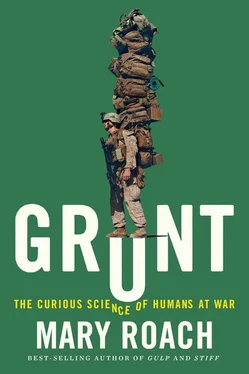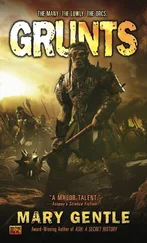The year was 1998. Dalton was undertaking research for the US military, still hot in pursuit of the Holy Grail of malodors, the “universally condemned smell.” She was traveling to Africa on an unrelated project and had decided to bring an assortment of malodors to test on Xhosa residents in a nearby township: one more culture weighing in. In her carry-on were bottles labeled Vomit, Sewage, Burned Hair, and US Government Standard Bathroom Malodor. Dalton had sealed and double-bagged the bottles but failed to take into account the change in cabin pressure. The liquids had expanded and leaked around the edges of their paraffin seals. Fortunately the overhead bin contained only her and her companion’s luggage. “I told him, ‘You can’t get anything out of the overhead compartment. Everything here at our feet is all we can have for the entire flight.’” As long as the compartment stayed closed, the odors would be largely contained—until the plane landed. And then what? “Here was my cleverness. I didn’t open the compartment until they had opened the doors of the plane. I figured that way people could blame it on something coming in from outside.”
Prior to her work with the Xhosa subjects, Dalton had exposed Asians, Hispanics, African Americans, and Caucasians to these same smells. The stand-out winner? US Government Standard Bathroom Malodor. “People hated it. They really, really hated it, and they thought it was dangerous.” Ernest Crocker was wrong about the Japanese. Among Dalton’s Asian subjects, comprising Japanese, Korean, Chinese, and Taiwanese, 88 percent—the highest percentage among all the ethnic categories—described it as an odor that would make them “feel bad.” It took the top slot in an Odor Repellency Ranking among all five ethnic categories. It repelled, by and large, everyone, with the exception of one unusually open-minded individual who judged US Government Standard Bathroom Malodor to be a “wearable” scent.
None of Dalton’s other bottled vilenesses approached a workable criterion of universality. Sewage Odor was no good at all. Fourteen percent of Hispanic subjects described it as an odor that would make them feel good. Around 20 percent of Caucasians, Asians, and black South Africans thought it smelled edible. Vomit Odor made a similarly poor showing, with 27 percent of Xhosa subjects describing it as a feel-good smell and 3 percent of Caucasians being willing to wear it as a scent. [48] This is not the reason International Flavors and Fragrances developed a proprietary vomit scent. They did so at the request of a company that planned to market it as a diet aid, a stick-up odor dispenser that would discourage you from eating by making your refrigerator stink like vomit. The item was never produced, because in tests, a certain percentage of people, particularly if they were hungry, had a positive response to the smell. They wanted to have it as a snack.
Dalton’s colleague Gary Beauchamp, Monell’s director at the time I visited, had had high hopes for Burned Hair, a stand-in for burning human flesh—an odor he felt confident all cultures would detest. What atrocities had Beauchamp spent time downwind of that he would have had this insight? “Nothing like that,” said Dalton. “He told me he used to peel skin off his fingers and put it on his coworkers’ lightbulbs, as a practical joke.” When the bulb was turned on, the heated peelings would start to smell. “I said, ‘Well that’s a side of you I didn’t know.’”
Unlike Vomit and US Government Standard Bathroom—malodors that exist ready-made—burned flesh/hair odor had to be concocted from scratch. Dalton convinced her hairdresser to collect a bag of floor sweepings, which she brought to the lab and pyrolized—pyrolization being a science lab version of leaving it on someone’s lightbulb. A mineral oil was infused with the collected vapors, and this is what subjects sniffed. Forty-two percent of Dalton’s Caucasian subjects thought Burned Hair smelled edible. Six percent of the Xhosa would wear it as a scent.
No one, it seems, wants to eat, wear, or be anywhere near the smell of a military field latrine. And so it was that Standard Bathroom Malodor became the starting point for Stench Soup. How has the smell served its country in the years since? Dalton shrugs. “I gave them the recipe. I have no idea what they did with it.”
IF YOU ever visit the Monell Center, chances are good you’ll be pressed into service as an “odor donor.” Someone will want to collect your breath or sniff your earwax or gather the gases exuding from your underarms. Chances are also decent that the study for which you have donated your aroma is funded by the United States Department of Defense. Of late, the military has taken an interest in the smell of stress. Were there a signature scent consistent from one stressed person to the next, something a sensor could pick out amid the clamor of perfume and cigarette smoke and last night’s garlic fries, then a sort of BO profiling could be undertaken. Sensors could be set up in airport security to identify suspected terrorists—though care would have to be taken to distinguish bombers from nervous fliers.
Body odors might also be used to monitor the stress level of personnel in high-pressure, high-risk jobs. A chemical sensor could be part of a so-called smart uniform. If stress compounds could be reliably detected on breath as well, the sensor could be part of a helmet mouthpiece. “We’re doing a pilot study for the Air Force,” Mauté told me. A pilot pilot study.
The goal would be intervention. If you hit a level of stress likely to compromise your ability to complete a task safely, an alert could be sent wirelessly to superiors. Your BO quietly turning you in. Alternatively, some kind of automatic intervention—say, a cutoff of the equipment—could be triggered.
I donated some stress smell earlier. Mauté had me put gauze pads in my armpits and count backwards by 13 from 200 while he timed me. When I made a mistake, I had to start over. At one point he threatened to post the footage on YouTube. My armpit gauze has been tweezered into a glass specimen jar like an exotic lace-winged insect. Mauté, having sniffed it, pronounced it “a wonderfully fresh BO smell.” [49] As opposed to a “stale-uriney BO smell,” the smell my stepdaughter Phoebe, as a little girl growing up in a big city, called hobo pee. Monell Chemical Senses Center BO expert Chris Mauté surmises that “hobo pee” is the smell of sweat and sebum that has been extensively broken down by bacteria: “the kimchee of body odor.”
Every now and then in life, a compliment is tucked so seamlessly into a insult that it’s impossible to know how to react. Around Monell, body odor seems to confer no shame. Seems to possibly even confer respect. When Mauté referred to a colleague as “ the donor in terms of his ability to produce body odor,” it seemed a kind of honorific, so much so that only much later did it occur to me to omit the man’s name.
The odor descriptor Monellians use for human flop sweat, the emotion-moderated secretions of the underarm apocrine glands, is “onion-garlic-hoagie.” Presumably there are odor descriptors for the smell of other animals’ stress, but you’d have to ask those animals, or the animals who hunt or harass them. If you wanted to know what distressed groupers smell like, for example, you could ask a shark. Or you could ask the US Navy.
11. OLD CHUM
How to Make and Test Shark Repellent

IF YOU WERE IN the market for a chemical that is harmless to humans but toxic to lesser classes of creature, you might reach out to someone in agriculture. A good pesticide, if there can be such a thing, combines both qualities. The insecticide rotenone was the topic of a 1942 memo from the US Department of Agriculture to the US Eleventh Naval District. In addition to killing bugs, rotenone, the letter stated, is a powerful fish poison. When added to water at concentrations only feebly toxic to humans, the chemical “stupefied goldfish.”
Читать дальше













